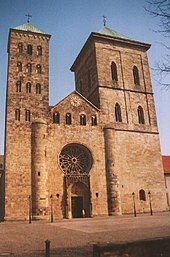Ibbenbürener sandstone
The Ibbenbüren sandstone (also coal sandstone ) is a quartz sandstone from the Westphalian ( Upper Carboniferous ), which is named after the town of Ibbenbüren in northern Westphalia in the Tecklenburger Land region , as the only aboveground deposits are located north of the town on the Ibbenbüren mountain plateau . Ibbenbüren sandstone has been a popular building material for centuries. It is characterized by its high resistance to weathering . It is not to be confused with the Osning sandstone , which occurs south of Ibbenbüren in the Teutoburg Forest and comes from the early Cretaceous .
Occurrence
The Ibbenbüren sandstone builds up a large part of the Ibbenbüren mountain range, a mountain range immediately north of Ibbenbüren. The mining takes place mainly in the western part of this ridge, which is also called Dickenberg . Quarries can be found especially in the areas of Dickenberg , Uffeln , Püsselbüren , Steinbeck and Obersteinbeck .
Emergence
The sand and gravel , from which the Ibbenbüren sandstone emerged, was deposited in the Upper Carboniferous , about 300 million years ago in the higher Westphalia (Westphalia C and D), on the northern edge of the foreland basin of the Variscan Fold Mountains ( Sub- Variscan fringing basin ). Then these layers of sediment were sunk to a certain depth and baked into sedimentary rock. As a result of the long-distance effect of the formation of the Alps, the earth's crust was lifted up in the northern edge of the Münsterland basin in the Tertiary , so that layers of carbon dioxide, including the Ibbenbüren sandstone, come to light there today. The so-called Bramscher Pluton is specifically made responsible for the elevation of the Ibbenbüren mountain plateau .
properties
The Ibbenbüren sandstone is medium to coarse-grained, sometimes also conglomerate, cemented with quartz and light gray, also yellowish or brownish in color. Its color ranges from gray to yellowish / reddish to brown. Due to a strong color structure, its grain appears decisive, which, however, results in a harmonious appearance in the overall picture.
Among the components, quartz predominates alongside rock fragments. Limonite precipitations occur in the form of conspicuous concentric rings, the so-called Liesegang's precipitation rings. In the highest strata of the Westfal D, which are being mined on the Kälberberg , primarily red hues appear.
Due to their formation and geological classification, small holes as well as clay, iron, pebble and other natural inclusions shape the unmistakable character of Ibbenbüren sandstone.
The compressive strength comes close to the values of coarse-grained granites.
Technical values
- Bulk density 2.44 g / cm³;
- Water absorption (atm.) 2.0% by weight;
- Compressive strength 120.7 N / mm²;
- Flexural strength 7.6 N / mm²;
- Abrasion resistance - cm³ / 50 cm²
- Anchor mandrel breakout load, with sliding sleeve at 4 cm thickness Fzul = 5% quantile / 3 = 0.39 KN
use
The Ibbenbürener sandstone is processed into bricks, window and door walls, facing bricks, block steps and floor slabs. It is frost-resistant and can be used indoors and outdoors.
Buildings made of Ibbenbürener sandstone:
- The Protestant church in Recke was built from this sandstone around 800 years ago, and to this day you can hardly see any signs of weathering
- St. Peter's Cathedral in Osnabrück
- Ev. Christ Church Ibbenbüren at the end of the 12th century,
- Numerous buildings in the region and beyond
The often widespread statement that the base of the Statue of Liberty in New York is made of Ibbenbüren sandstone is not true. According to an official letter from the city of Ibbenbüren to the city of New York, the city of New York made it clear that the base of the Statue of Liberty is not even made of sandstone.
Similar rocks
See also
literature
- Otto Sickenberg: stones and earth. The deposits and their management. Geology and Deposits of Lower Saxony , 5th volume, Dorn-Verlag, Bremen, Horn 1951, pp. 125ff.




